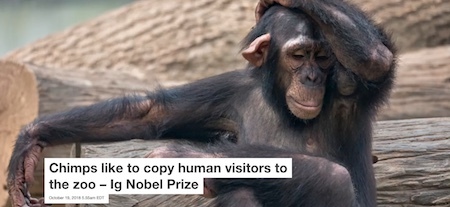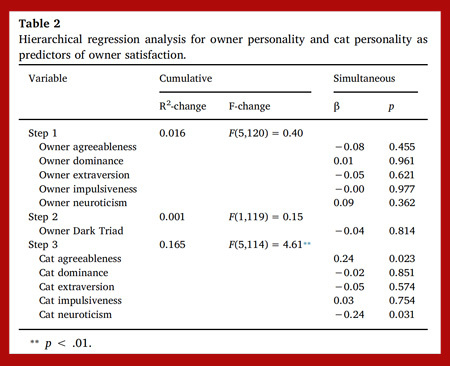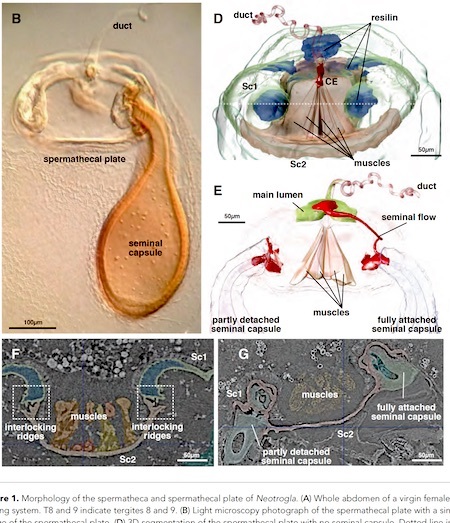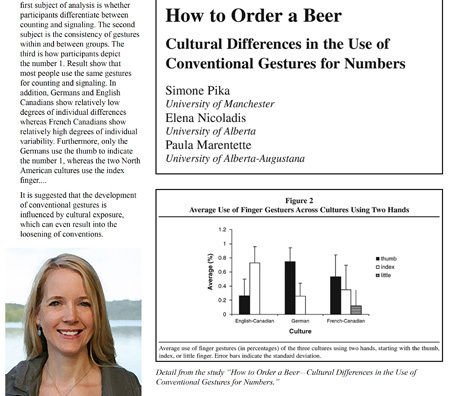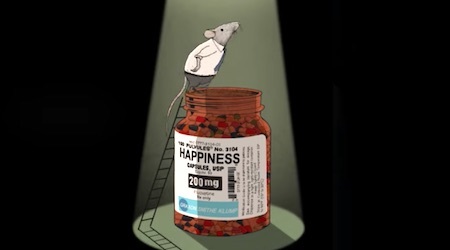Marc Abrahams's Blog, page 169
October 20, 2018
Explanation, by Ig winners, of imitation of chimps and people by each other
The 2018 Ig Nobel Anthropology Prize winners explain their research about chimpanzees and humans imitating each other, in an essay published by The Conversation.

October 19, 2018
A Million Random Digits [research study, with implied drama]
The book A Million Random Digits with 100,000 Normal Deviates is appreciated in the article “A Million Random Digits,” which is one of the articles in the special Numbers issue of the Annals of Improbable Research, which is one of the 142 issues published so far!
The original, digit-laden study was published by the Rand Corporation in 1955. We so appreciate that original study that we produced this video version of our appreciation:

October 18, 2018
‘The Man in the Ear’ (a fresh look)
It was back in the 1950’s that Dr Paul Nogier of Lyon, France, noticed that it’s possible to superimpose an image of a human fetus onto one of the human ear [see dwg.]
This discovery led him to develop his theories of Auriculotherapy which he later described in his book ‘The Man In The Ear’ [possibly out of print at present]
For a modern-day overview of Auriculotherapy, see : Scientific Basis of Auriculotherapy: State of the Art (Med. Acupunct., Apr. 1st, 2014, 26(2): 84–96) which comes to the conclusion that :
“More scientific research should be performed to improve the scientific credibility of auriculotherapy.”
Note: Enthusiasts of Reflexology believe that areas on the foot (and/or the hand) rather than the ear, also correspond with organs in the “zones” of the body.
The illustration is from Auriculotherapy Manual, 4th Edition • 2014 (Churchill Livingstone, £59.39)
[ Research research by Martin Gardiner ]

Cat Owners’ Personalities, and Satisfaction With Their Cats [research study]
Evidence mounts about what kinds of cat owners are satisfied with their cats. This new study explains:
“The Purrfect Match: The Influence of Personality on Owner Satisfaction with Their Domestic Cat (Felis silvestris catus),” Rebecca Evans, Minna Lyons, Gayle Brewer, Sonia Tucci, Personality and Individual Differences, vol. 138, 2019, pp. 252–256.
The authors (one of whom—Minna Lyons—is a 2014 Ig Nobel Prize winner for amassing evidence that people who habitually stay up late are, on average, more self-admiring, more manipulative, and more psychopathic than people who habitually arise early in the morning), at the University of Liverpool, UK, explain:
“Participants (11 men and 115 women) were recruited via advertisements placed on social media and in a local cattery….
“[C]at owners (N=126) completed a two section questionnaire. The owner section assessed three of the Big Five traits (agreeableness, extraversion, neuroticism), dominance, impulsiveness, the Dark Triad (narcissism, Machiavellianism, psychopathy), and owner satisfaction with their cat. The pet section assessed the Feline Five (agreeableness, dominance, extraversion, impulsiveness, neuroticism). Positive associations were identified between owner and pet dominance and owner and pet impulsivity. Higher owner dominance also positively correlated with cat extraversion, impulsivity, and neuroticism and owner Dark Triad traits were positively correlated with cat dominance, impulsivity, and neuroticism. None of the owner personality traits related to satisfaction with the cat. Overall, owners were more satisfied with cats high in agreeableness and low in neuroticism. Dissimilarity in owner dominance and cat agreeableness, and owner impulsivity and cat agreeableness were correlated with higher satisfaction. Satisfaction was also positively associated with similarity in scores for owner Dark Triad and cat agreeableness.”

October 17, 2018
A Biological Switching Valve Discovered in the Famous Sex-Role Reversed Cave Insect
The team that won the 2017 Ig Nobel Biology Prize for discovering a female penis, and a male vagina, in a cave insect has published a new paper, reporting a further discovery about the body parts of that insect.
Their new paper is “A Biological Switching Valve Evolved in the Female of a Sex-Role Reversed Cave Insect to Receive Multiple Seminal Packages,” Kazunori Yoshizawa, Yoshitaka Kamimura, Charles Lienhard, Rodrigo L Ferreira, Alexander Blanke, eLife, 2018;7:e39563. The team explains:
“In dry caves of southeastern Brazil, live a group of insects named Neotrogla that are perhaps best known because the egg-producing females have penises while the sperm-producing males have vaginas. The sex roles of these Brazilian cave insects are also reversed: females compete over the males, who in turn are selective of their female partners….
“The valve complex has two slots for insemination so that Neotrogla can continue mating while the first slot is occupied. In conjunction with the female penis, this switching valve is a morphological novelty enabling females to compete for seminal gifts in their nutrient-poor cave habitats through long copulation times and multiple seminal injections.”

October 16, 2018
Does this count as cannibalism?
The headline in the Los Angeles Times reads “Teen baked her grandfather’s ashes into sugar cookies and brought them to school, police say.” Does this count as cannibalism?
The question arises because one month ago the 2018 Ig Nobel Prize for nutrition was awarded to James Cole of the University of Brighton, for calculating that the caloric intake from a human-cannibalism diet is significantly lower than the caloric intake from most other traditional meat diets.
That research is described in the study “Assessing the Calorific Significance of Episodes of Human Cannibalism in the Paleolithic,” James Cole, Scientific Reports, vol. 7, no. 44707, April 7, 2017.
Questions of cannibalism and nutrition are, one might say, grandfathered into the Los Angeles news report.
BONUS: A television news report on KFDM.

How to order a beer [research study, about numbers]
“How to Order a Beer—Cultural Differences in the Use of Conventional Gestures for Numbers,” is one of several studies featured in the article “Numbers Research — research some people think they can count on,” which is one of the articles in the special Numbers issue of the Annals of Improbable Research, which is one of the 142 issues published so far!
The beer ordering study is by Simone Pika, Elena Nicoladis, and Paula Marentette, published in The Journal of CrossCultural Psychology, vol. 40, no. 1, 2009, pp. 70-80.

October 15, 2018
Happiness
This short film, “Happiness,” by Steve Cutts, appears to sum up generations of psychology research on the topic. Its full of rats, and except fleetingly, devoid of happiness.
(Thanks to Fariba Houman for bringing this to our attention.)

Correlations: Left-Handers and Right-Wingers (new study)
“It seems axiomatic to assume that handedness is unrelated to actual placement on the political spectrum. Nevertheless, primed by my longstanding research interest in personality and political preference (e.g., McCann, 1997, 2014a, 2014b), I was struck by the rough similarity of a map of the percentage of left-handers in each state in 1986 (McManus, 2009, p. 48) to a map of the Republican and Democratic states in the U.S. presidential election of 2012.”
 The author of a new paper for the journal Laterality, Professor Stewart J. H. McCann of the Department of Psychology, Cape Breton University, Sydney, Canada, has found that, in the US, state levels of left-handedness correlate to an extremely high degree with Conservative-Republican preference.
The author of a new paper for the journal Laterality, Professor Stewart J. H. McCann of the Department of Psychology, Cape Breton University, Sydney, Canada, has found that, in the US, state levels of left-handedness correlate to an extremely high degree with Conservative-Republican preference.
An explanation, though, is currently lacking :
“Faced with the results of the present research, we should strive to arrive at the best explanation, regardless of the theoretical and procedural difficulties or the existing boundaries of disciplinary and sub-disciplinary persuasions. To understand the links between personality, political orientation, handedness, and genetics has profound implications for the dynamics of democracy.”
[ Research research by Martin Gardiner ]

October 12, 2018
Memoirs of an Ig Nobel volunteer
Neil Gussman, who helps maintain a proper level of apparently-incipient-chaos at the Ig Nobel Prize ceremony, marshaled some of his thoughts about it:
…My first volunteer job with the Ig Nobel was ushering at the Ig Nobel ceremony at the AAAS meeting beginning in 2006. However, after I returned from Iraq in 2010, Marc added me to the volunteer staff in Cambridge as a press wrangler. Each year I escort reporters in and out of the ceremony. Because of copyright and legal restrictions, broadcast reporters are limited in how much time they can record. My particular job is to escort the reporter and cameraman from Channel One (ПервыйКанал) in Russia. Camera crews from many countries have filmed the Ig Nobel ceremony over the years, but Channel One Russia and NHK Japan have been there every year since I have been a volunteer.
This year, for the first time…

Marc Abrahams's Blog
- Marc Abrahams's profile
- 14 followers


